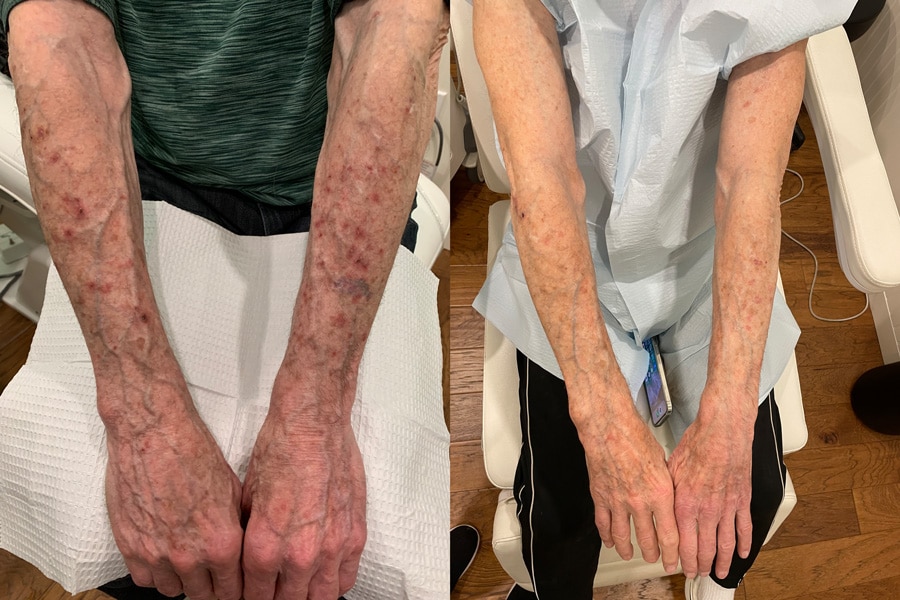
Actinic Keratosis
Actinic keratosis is a dermatological skin condition that can feel like rough skin or consist of skin changes such as redness, raised areas of skin, or white and yellow scales. These skin changes can sometimes progress to become skin cancer. It is recommended that all actinic keratoses be treated since it is impossible to predict which of these precancerous lesions will develop into skin cancer.
Book a consultation at our Vancouver clinic.
Learn More About Actinic Keratosis
Actinic keratoses occur due to sun exposure. The harmful UV rays of the sun can disrupt the development of skin cells over time, damaging the skin’s DNA. Actinic keratoses are a form of abnormal cell growth and are considered to be precancerous.
These lesions occur in sun-exposed areas, such as the face, ears, arms, scalp, and back of the hands. Actinic keratoses are more likely to affect light-skinned individuals and people with photosensitive skin, as well as people who work outdoors or have had a considerable amount of time in the sun. It is incredibly important to use a high-quality SPF if you are going to be experiencing prolonged sun exposure.
Some precancerous skin growths go on to become a type of skin cancer called squamous cell carcinoma. There’s no way for your dermatologist to know which ones will progress to skin cancer. When you get rid of an actinic keratoisis, or AK, through treatment, it is less likely to develop into skin cancer. Treatment can also relieve symptoms, such as itching or tenderness.
Some people need multiple and repeat treatments. If you have severely sun-damaged skin, you may have many AKs, some of which you may be able to feel on your skin but not see. These hidden AKs can feel gritty, and some people compare them to sandpaper. To treat both the visible and hidden AKs, your physician may recommend that you have more than one type of treatment. You may also need to apply medication at home. This reduces the amount of time that you need to treat the AKs and reduces your risk of developing skin cancer.
Sun protection delivers big benefits during and after treatment. Many people who have precancerous skin growths are surprised to learn that they need to protect their skin from the sun. They often think that the damage is done, so what’s the point? If you have a precancerous skin growth, protecting your skin from the sun offers two big benefits:
1) It helps to prevent the sun from causing further damage to your skin, which could lead to more precancerous growths or skin cancer, and 2) It gives your body a chance to repair some of the damage to your skin. If you’re unsure about how to protect your skin, you can learn what to do to Prevent skin cancer.
Acne Treatment at Shine MD
At Shine MD, we offer medical actinic keratosis treatments through our medical skin care clinic. These include liquid nitrogen treatments and medicated creams, as well as research-proven laser treatments.
Liquid Nitrogen
Liquid nitrogen can be applied to individual spots during a visit to the clinic. This works best when only a few spots are present and the patient is not eager to treat an entire area, such as the face or arms. Mild redness, blistering, hypopigmentation, and hyperpigmentation are common side effects associated with treatment.
Medicated Creams
Medicated creams aim to treat areas that have multiple spots of actinic keratosis and have diffuse signs of sun damage. These medications are formulated to selectively enter the abnormal cells and destroy them.
Efudex (5-Fluorouracil) is a patient led, home based treatment that is applied daily for 2-4 weeks. During treatment, the affected skin becomes red and scaly. After a period of time, you will see the areas of actinic keratosis or sun damage become more obvious. After this phase, the healing process occurs.
Metvix Photo Dynamic Therapy is an office-based cream application that is performed during the summer months. Prior to your appointment, the area will be pre-treated with a retinol cream for one week. On treatment day, the lesions of concern are gently scraped or roughened with a curette. Then, your care provider will apply sunscreen, followed by the medication Metvix (methylaminolevulinate). You will then be instructed to go outside and spend at least two hours in the daylight to activate the medication before returning home and washing the treated area.
You will be advised to avoid any sun exposure for 48 hours after the cream application. Depending on the extent of sun damage, two treatments may be performed one to two months apart. The healing phase varies depending on the extent of sun damage present. Some patients have extended drug coverage that will cover the cost of the medication. Clinic fees apply for administration and application.
Laser Based Treatments
Laser based treatments are effective at reducing the presence of abnormal sun-damaged cells. Patients who are seeking overall facial rejuvenation, pigment reduction, and treatment of actinic keratoses will often opt for laser treatment. Ablative lasers such as the Halo, Moxi and the Contour TRL Laser Peel are treatments of choice.
Customized laser resurfacing treatments performed by Dr. Khurana involve the use of several innovative technologies to resurface damaged skin cells and improve fine lines and wrinkles around the eye and mouth areas.
Discover Our
Before & After Gallery
Want to see real patient results from our innovative skin treatments? View our impressive before and after images in our photo gallery.

*Individual results may vary.
